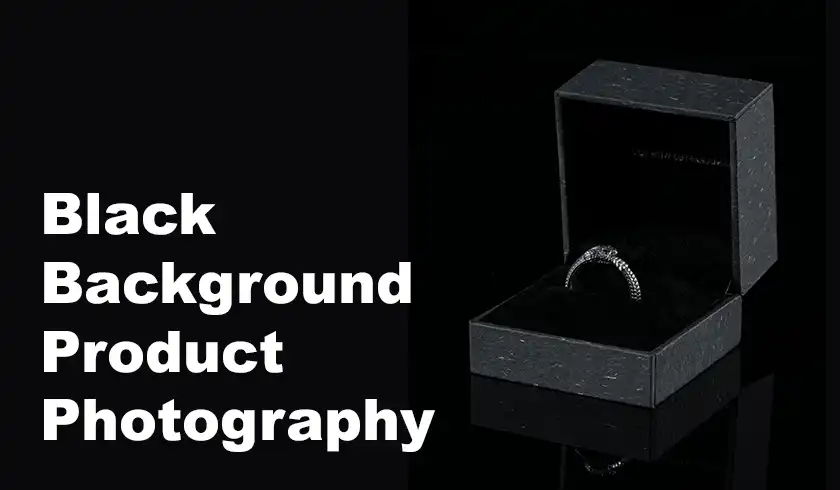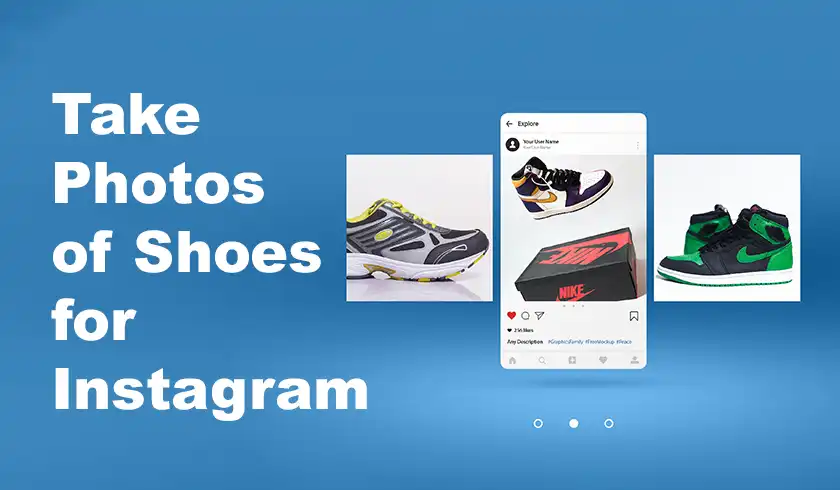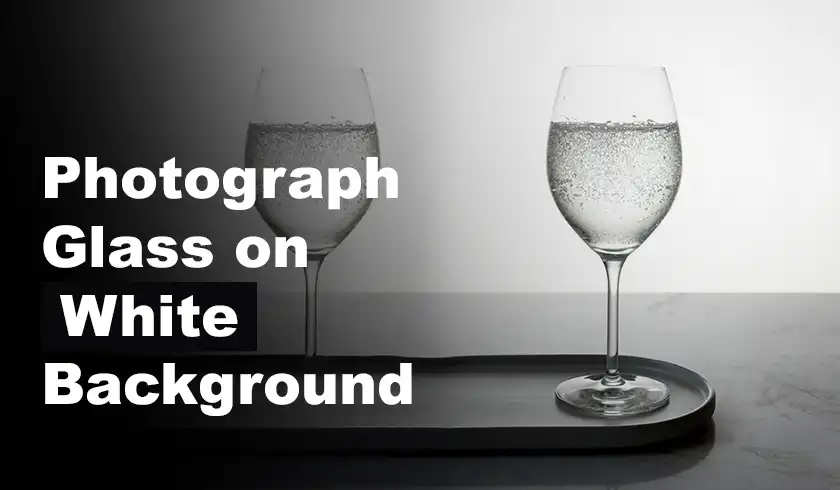Stunning product photos can make or break your sales. And when it comes to creating that wow factor, black background product photography is a game-changer. It’s like the little black dress of product photos – timeless, and elegant, and it makes your product the star of the show.
But here’s the thing: nailing that perfect black backdrop isn’t as simple as just turning off the lights. It’s an art form that requires a bit of know-how. Whether you’re selling sleek gadgets, glitzy jewelry, or gourmet goodies, these tips will help you create photos that pop, sizzle, and sell. So, grab your camera and let’s dive into the dark (but exciting!) world of black background product photography!

Tip 1 – Lighting Considerations is Important
Lighting in black background photography is like being a ninja – it’s all about control and precision. 🥷 Get this right, and your product will shine like a diamond in the night sky.
Maximize Light on the Subject
First things first: your product needs to be the star. Think of it as being on a stage with a spotlight. You want all eyes (or in this case, all light) on your product. This is crucial when you’re doing black-on-black photography, like showcasing a sleek black smartwatch on a black background. The key? Light up that watch without letting the light spill onto the backdrop.
Adjust Light Intensity
Distance is your friend here. Move your lights closer to the product and further from the background. It’s like playing hide-and-seek with light. The closer the light is to your product, the brighter it’ll be. But if it’s too close to the backdrop, you might start picking up little imperfections – a wrinkle here, a shadow there. And trust me, those tiny distractions can pull the viewer’s eye away from your gorgeous product faster than you can say “clearance sale.”
Rim Lighting or Background Light
Ever seen those cool photos where the product seems to glow around the edges? That’s rim lighting, and it’s your secret weapon for separating your product from the black abyss behind it. This is especially handy for flat-lay photos – think an array of colorful macarons or a stylish pair of sunglasses. A subtle background light can also do the trick, creating just enough separation to make your product pop.
Tip 2. Do Product Positioning Properly
Positioning your product is like playing a game of 3D chess. Every angle, every shadow, every reflection matters. Get this right, and your product will look so good, customers will be hitting that ‘Add to Cart’ button faster than you can blink!
Experiment with Angles
Don’t just plop your product down and call it a day. Play around! Try a flat-lay for those earrings, showcasing how they’d look scattered on a vanity. Or go low with the camera for a perfume bottle, making it look tall, elegant, and oh-so-tempting. Different angles add depth and intrigue. It’s like giving your product a personality – sometimes it’s playful, sometimes it’s sophisticated.
Positioning for Shadows
Shadows can be your best friend or your worst enemy. If you’re using a glossy surface (hello, sleek tech gadgets!), you want to keep your product a bit farther from the backdrop. Why? Because light loves to bounce around on shiny surfaces. Too close, and that light might spill onto your carefully crafted black background. It’s like trying to keep a secret in a room full of mirrors – tricky, but doable with the right positioning.
Reflectors
Think of reflectors as your light-wrangling sidekicks. They help control those pesky light spills. It’s like setting up a mini light-control fortress around your product. A well-placed reflector can mean the difference between a so-so shot and one that looks like it belongs in a high-end catalog.
Tip 3 – Background Material
Your choice of background material is like picking the right canvas for a masterpiece. It sets the stage for your product to shine. And when it comes to black backgrounds, not all materials are created equal.
Velvet
Ladies and gentlemen, meet the reigning champion of black backgrounds: velvet. This material is like a black hole for light – it just absorbs it all. Velvet is so good at its job that you can place your product super close to the backdrop without worrying about light bouncing back. Imagine trying to photograph a delicate silver necklace. With velvet, it’ll look like it’s floating in a sea of darkness.
Other Options
Now, I’m not saying it’s velvet or bust. There are other contenders in the ring:
- Foam Boards & MDFs: These are like the workhorses of the background world. Sturdy and reliable.
- Poster Boards & Paper Rolls: Great for smaller products. Think of them as the paper plates of photography – convenient and disposable.
- V-flats: These are the multitaskers. They can block light, reflect light, and act as a backdrop.
- Canvas & Black Fabric: These add a bit of texture. It’s like having a subtle pattern in a black suit – interesting, but not distracting.
But remember, while these all have their place, velvet is usually the MVP when it comes to that inky, light-absorbing black.
Tip 4 – Exposure Settings
Now we’re getting into the nitty-gritty. Your camera settings are like the secret recipe for your grandma’s famous cookies – get them right, and the results are irresistible.
ISO
Think of ISO as your camera’s sensitivity to light. For black backgrounds, you want it low – between 100 and 125. It’s like turning down the volume on your camera’s light sensor. The lower it is, the darker your background will be. Hello, velvety blackness!
Aperture
The aperture is like the pupil of your camera’s eye. A narrow aperture (higher f-stop number) lets in less light. Aim for somewhere between f/1.4 and f/5.6. But be careful! Go too narrow (like f/22), and everything gets super sharp. That’s great for landscapes, but for products? You might start seeing every tiny imperfection.
Exposure Compensation
This is your “oops” button. If your product is basking in too much light, use negative exposure compensation. It’s like telling your camera, “Whoa there, tone it down a bit!” This will underexpose your background, making it blacker than night, while your product stays perfectly lit.
Shutter Speed
Shutter speed is like controlling how long your camera blinks. A faster blink (higher shutter speed) means less light gets in. Try between 1/200 and 1/250 of a second. But hey, every setup is different. Play around! It’s like finding the perfect dance move – it might take a few tries, but when you get it, oh boy, it’s magic!
People Also Ask
1. Can I use a black sheet as a backdrop?
You can, but it’s not ideal. Sheets can wrinkle easily, and those wrinkles catch light. It’s like trying to create a calm lake surface with a rumpled bedsheet. Stick to materials like velvet or foam boards for that smooth, pro look.
2. How do I avoid reflections on shiny products?
Ah, the bane of every product photographer! Try adjusting your light angles. Sometimes, a slight tilt of your product can make all the difference. Also, consider using a polarizing filter – it’s like sunglasses for your camera, cutting out unwanted reflections.
3. Can I use natural light for black background photos?
It’s tricky, but not impossible. You’ll need to control the light more – think heavy curtains and reflectors. But honestly? For consistent results, artificial lighting is your best friend. It’s like baking – precise control leads to perfect results every time.
4. How do I get the background totally black in post-processing?
Post-processing is your safety net. Use the levels or curves tool to deepen the blacks. But remember, it’s always better to get it right in-camera. Post-processing is like salting your food – a little can enhance, but too much can ruin the dish.
5. Can I use these tips for non-product photos, like portraits?
Absolutely! These tips are like the little black dress of photography – versatile! Just adjust for your subject. For portraits, you might want a softer light to flatter skin tones. It’s all about adapting to make your subject shine.
Bottom Line
We did it! We’ve learned so much about taking amazing product photos with black backgrounds. Remember, good lighting, smart positioning, the right background (hello, velvet!), and the right camera settings are your friends. They help make your products look fantastic!
Why does this matter? Because great photos make people want to buy your stuff! Whether you’re selling pretty earrings, cool gadgets, or yummy treats, these tips will make your products shine.

